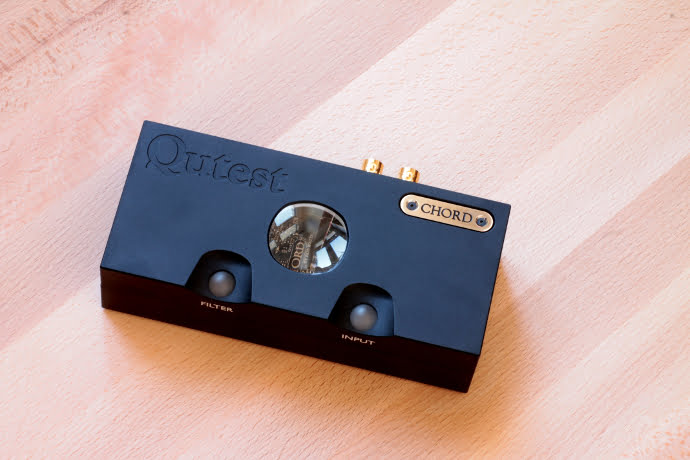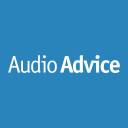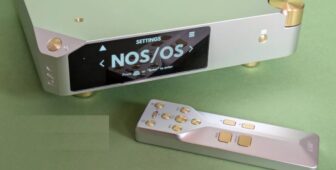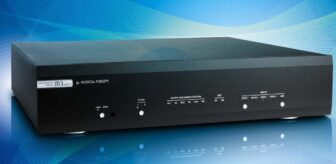Chord Electronics Qutest Review
As its most affordable home DAC, this pared-back design uses Chord’s advanced FPGA chip and offers extensive file support

If you’ve been keeping up with Chord Electronics’ pretty extensive range of digital-to-analogue converters you’ll know that the 2Qute (HFC 402) was closely related to the Hugo (HFC 386), boasting the company’s distinct Chordette casing but without the rechargeable battery and variable output. Similarly, the Qutest is the same relation to the Hugo 2 (HFC 428), inasmuch as it’s a simplified, pared-down version without the portability and a few other non-essential. It also loses the Chordette casework, looking a lot more like the Hugo 2. So, your £1,195 buys you Chord’s latest and most advanced FPGA chip, four different user-selectable filters and the same wide range of file compatibility. There are also some interesting new features that you don’t get from its portable brother.
Unlike the vast majority of digital- to-analogue converters on sale, Chord uses its own custom-made digital conversion hardware. The Rob Watts-designed Field Programmable Gate Array at the heart of the Qutest
DETAILS
PRODUCT Chord Electronics Qutest
ORIGIN UK
TYPE DAC
WEIGHT 770g
DIMENSIONS (WxHxD) 160 x 41 x 72mm
FEATURES
- 32-bit/768kHz PCM and DSD512- capable DAC
- Inputs: 1x optical; 1xUSB-B;2 x BNC coaxial
- Output: 1x RCA phonos
DISTRIBUTOR Chord Electronics Ltd.
TELEPHONE 01622721444
WEBSITE chordelectronics.co.uk
is not simply repurposing other peoples’ ideas of DACs and digital filtering – it is exclusive to the brand, not bought off-the-shelf. The Watts Transient Aligned digital filter uses clever mathematics, implemented on a huge Xilinx Artix 7 FPGA to give a far higher tap-length than that seen in stock DAC chips. There are 49,152 taps, compared with 26,000 in its predecessor and approximately 150 in standard DACs, says Watts. This, he claims, translates to better time domain performance, among other things.
The Qutest features a USB Type-B input that runs up to 32-bit/768kHz resolution. Two BNC coaxial digital inputs are fitted offering the same specs, and the Toslink optical input goes up to 24-bit/192kHz. In addition to PCM it supports up to DSD512 (so-called octa-DSD). The dual BNCs flag up the prospect of dual data communications with a possible future Chord Electronics transport and/or upsampler. Unlike the Hugo 2, these inputs are galvanically isolated, which eliminates the transmission of digital noise via the digital outputs of lesser ancillaries. One pair of RCA phono outputs is fitted, and runs at a fixed level, but variable between 3V, 2V and 1V (changeable by pressing both Filter and Input buttons on startup). This is a clever feature, because you can tune it for the sort of preamp you use – be it passive, solid-state, tube or whatever.
The John Franks-designed casework is new, and a dramatic improvement over what came before in my view. It brings a beautifully surfaced modem look, and is significantly heavier. Precision machined from solid aircraft-grade aluminium billet, the PCB sits in a smallish cavity inside the case. In addition to the trademark glass window – which is a great feature because it adds a bit of eye-catching drama that everyone in the household will love, as well as providing some practical visual indication of the sampling frequency by means of colour – there are two acrylic buttons that control the frequency-shaping filters, and input selection; again these change colour depending on the option selected.
Like Henry Ford’s Model T car, it’s available in any colour you like as long as it’s black; which is a bit of a shame because I feel I would opt for a silver version if one became available. Finally, power comes into the unit via a 5V, 2A micro USB supply.
Chord Electronics’ DACs seem able to communicate particularly well at an emotional level, in a way that most others cannot. The Qutest is no exception – it’s the cheapest serious digital converter that the company produces, yet you wouldn’t be able to tell by listening to it. It’s rather like its DAVE bigger brother – doing what all Chords do, albeit on not quite such a grand scale.
Sound quality
ABC’s Date Stamp is a sugary piece of classic eighties pop, yet the Qutest captures the song’s deep groove and from then on in you’re hooked. Most rivals give you a strong and detailed presentation, but make the musicians sound like they’re going through the motions. Bass guitar, for example, is really bouncy, but more than that it is delivered in perfect time relative to the rest of the mix; everything seems snappy and nicely syncopated and the Chord’s great sense of timing is hard not to fall in love with.
In other respects, it’s also highly accomplished. For example, it conjures up a deep and wide recorded acoustic. It’s not spectacularly good, but of particular interest is the pinpoint precision with which instruments are located. It certainly makes the ABC track snap into focus, as if the auto-focus on your camera smartphone finally gets a lock on to what you want to photograph.
It’s truly impressive on classical music, though, where things are done on a larger scale altogether. The way it hones in on different instrumental sections in the Berlin Philharmonic Orchestra’s rendition of Beethoven’s Pastoral Symphony, for example, is a revelation. The Qutest doesn’t quite match the vast, panoramic scale of its DAVE bigger brother, but the recorded acoustic is still impressively wide; within this there’s a fabulous sense of focus that makes things sound bold and highly defined.
You get this with jazz, too. My well-played Japanese Bluenote CD copy of Herbie Hancock’s Maiden Voyage is a joy to hear. There is a great sense of being transported back – TARDIS-like – to the time and place of the recording. The soundstage is beautifully etched with the piano sounding so solid it could have been bricked into my listening room wall. What really strikes me here, though, is the sweet, smooth tonality of the Qutest. It sounds more natural than anything else at or near the price; it’s smooth, even and is able to communicate the natural tonal patina of acoustic instruments surprisingly well. Some of its price rivals can strip the colour out of warm recordings, almost as if you’ve brought the saturation setting right down to zero on your photo editing software. Whether it is strings or brass, the performance just sounds so much more natural and organic here.
Dynamically, the baby Chord is great. The real test of a DAC’s mettle, however, is slow, soft soul, which can sound like wallpaper music through the wrong system. Rose Royce’s beautiful Wishing On A Star sounds like anything but, transfixing me from the start. The way the Qutest carries the expressive emotion of the vocals is a delight. Not only is the timbre of the singer’s voice a pleasure to hear, but the DAC is able to impart every last inflection. With out-and-out dynamic crescendos, there’s just a hint of compression, but you’ll have
The Qutest DAC is able to impart every last inflection of the singer’s vocals
to spend a lot more money than this to find a DAC that does any better here. Allied to the Chord’s lovely, beguiling rhythms, it makes for a superb listen – giving a spookily natural quality to the sound that is very impressive at the price.
Conclusion
Regardless of file format, sampling rate or input, I find that this is a great sounding digital converter – indeed spectacular at the price. You can run the gamut of your digital music collection – from classical to country, folk to electronic – and hear things presented in a detailed, intricate and incisive way, yet one that absolutely nails the basic emotion of the track. Even disregarding its superlative styling and build quality, the stellar sound quality alone warrants enthusiastic recommendation.
Meet the new class of the field.
OUR VERDICT
When you purchase through links on our site, I may earn an affiliate commission. Here’s how it works.









